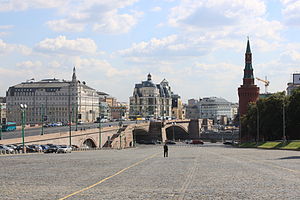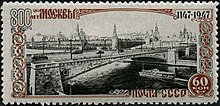Bolshoy Moskvoretsky Bridge
This article needs additional citations for verification. (February 2015) |

55°44′56″N 37°37′28″E / 55.74889°N 37.62444°EThe Bolshoy Moskvoretsky Bridge (Russian: Большой Москворецкий мост) is a concrete arch bridge that spans the Moskva River in Moscow, Russia, immediately east of the Kremlin. The bridge connects Red Square with Bolshaya Ordynka Street in Zamoskvorechye. Built in 1936–1937, it was designed by V. S. Kirillov (structural engineering) and Alexey Shchusev (architectural design).

Moskvoretsky bridge (1829/1872, demolished)[edit]
Wooden bridges east of the Kremlin have existed since the fifteenth century, as witnessed by Venetian Ambrogio Contarini, who travelled through Moscow in 1476.
The first permanent Moskvoretsky bridge was built in 1829, about 50 metres (160 ft) west of the present site. Three wooden arches, each 28 metres (92 ft) long, were supported by stone abutments. It was loosely based on Kamennoostrovsky Bridge in Saint Petersburg designed by Agustín de Betancourt. The bridge burned down in 1871; after the fire, steel arches and decking were installed on the old abutments.
Bolshoy Moskvoretsky bridge (1937)[edit]


In 1935–1938, all the bridges in town centre Moscow were replaced with high capacity ones. Moskvoretsky Bridge was the first to be completed, and was the only concrete bridge of the 1930s. The bridge was placed at the narrowest point of the Moskva River, west of its predecessor; as a result, blocks of Zaryadye and Balchug were razed to make way for construction.[1]
The main arch of the current bridge consists of three concrete boxes, 92 metres (302 ft) long and 6.1 metres (20 ft) high. The two arches over the embankments are each 42.8 metres (140 ft) long. The bridge has a total width of 40 metres (130 ft) (8 lanes), and its total length with approach ramps is 554 metres (1,818 ft). Although it is a concrete structure, Alexey Shchusev finished the bridge in pink granite slabs to create the illusion that the bridge is actually built in stone.
Notable events[edit]
On 27 May 1987 German aviator Mathias Rust landed on the bridge.[2][3]
On 27 February 2015 opposition politician Boris Nemtsov was shot to death while crossing this bridge.[4][5][6][7]
Bibliography[edit]
- Носарев, В. А.; Скрябина, Т. А. (2004). Мосты Москвы [Bridges of Moscow] (in Russian). Moscow: Вече. pp. 94–101. ISBN 5-9533-0183-9. OCLC 57465831.
See also[edit]
References[edit]
- ^ Коллега А. В. Щусева – Патвакан Маркарович Сардарьян, см.: Правда: газета. – № 273. – 3 октября 1937; а также в кн.: История Москвы. Т. 6 // Ин-т истории (АН СССР). – М.: Изд-во АН СССР, 1959. – С. 110.
- ^ LeCompte, Tom (July 2005). "The Notorious Flight of Mathias Rust". Air & Space/Smithsonian. Washington, D.C.: Smithsonian Institution. Retrieved 4 April 2009.
- ^ Hadjimatheou, Chloe (7 December 2012). "Mathias Rust: German teenager who flew to Red Square". BBC World Service. Retrieved 17 March 2014.
- ^ "Russia opposition politician Boris Nemtsov shot dead". BBC Online. 28 February 2015. Retrieved 28 February 2015.
- ^ Heritage, Timothy; Golubkova, Katya (28 February 2015). "Russians to march in memory of murdered critic of Putin". Reuters. Archived from the original on 2 April 2015. Retrieved 10 April 2015.
- ^ Amos, Howard; Millward, David (28 February 2015). "Leading Putin critic gunned down outside Kremlin". The Telegraph. Retrieved 10 April 2015.
- ^ Amos, Howard (1 March 2015). "Russian opposition leader Boris Nemtsov's murder caught on CCTV". The Telegraph. Archived from the original on March 2, 2015. Retrieved 10 April 2015.
